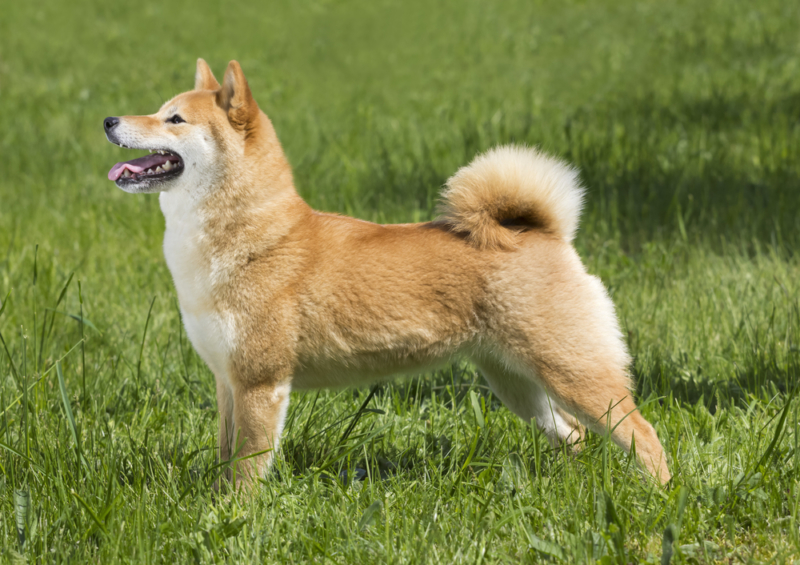Most people think of the Shiba Inu or Akita Inu when it comes to Japanese dog breeds, but Japan has many incredibly unique types of dogs. In this article, we’ll show you some of the other rare and wonderful Japanese dog breeds that you would be hard-pressed to see elsewhere. We’ve also got some interesting domestic destinations that dog fans can’t miss out on. Get ready to have your hearts stolen by these unbelievably adorable doggies!
Nihon Ken vs. Japanese Dogs
Anyone who can read a little bit of kanji might think that “Nihon Ken” (日本犬) means “Japanese dogs,” and therefore all Japanese dogs are “Nihon Ken.” They would be incorrect.
“Nihon Ken” refers to native Japanese dog breeds, of which there are six: the Shiba Inu, Kishu Inu, Shikoku Ken, Kai Ken, Hokkaido Inu, and Akita Inu. They have collectively been designated as Natural Monuments by the Japanese government.
There are also a few more breeds that are distinctively Japanese, but are not included in the “Nihon Ken,” mainly because of their origins. These include the Tosa Ken, Japanese Chin, Japanese Spitz, and the Japanese Terrier.
Now that you know the difference, let us introduce all of these dog breeds!
Nihon Ken Breeds
・Shiba Inu

The Shiba Inu is a Japanese dog breed with a long history with humans. In fact, they can be traced back to the Jomon period (around 12,000 to 4,500 years ago), where they were bred to be hunting dogs. This is a small-to-medium breed weighing in at around 9 kg on average. Sporting sharp ears, short fur, and a curled tail, these guys are very independent and wary of strangers, yet loyal and loving towards their owners. They are a beloved breed that have been steadily gaining more attention across the globe in recent years. The even smaller Mame-shiba only weighs around 4 to 6 kg, and has also become increasingly popular lately.
・Kishu Inu

Originating from the mountainous area in Western Japan between Wakayama, Mie, and Nara, the Kishu Inu was bred to be a hunter. Weighing anywhere between 13 to 27 kg, they have a beautiful white coat and distinct facial features. They tend to have lots of stamina and carry a calm, yet bold, personality. They are also known to be easy to train due to how extremely loyal they are towards their owners.
・Shikoku Ken

Just as the name suggests, this Japanese dog breed originated in Shikoku, one of the 4 main islands that make up Japan. They performed admirably as hunting dogs, and weigh around 15 kg on average. Because their coats are similar in color to the Japanese wolf, there have been incidents where some were mistaken for wolves, causing a fuss in the areas they were sighted in. Intelligent and competitive by nature, they need an experienced owner with a steady hand to keep them out of trouble.
・Kai Ken

These dogs were used to hunt in the Southern Alps of Yamanashi Prefecture. Weighing anywhere from 12 to 18 kg, they have sharp features and wild looks, and as they grow they gain more and more brindle markings, reminiscent of tigers. Having been bred for hunting, they require strict discipline, and hence may not be suited as a house pet.
・Hokkaido Inu

This breed is sometimes referred to as the Ainu Ken, as they have been a part of the Ainu lifestyle for a very long time. The Ainu are the indigenous people of Hokkaido, and these dogs have developed to withstand the harsh winter of Hokkaido with them. For this reason, they have two separate types of fur, but this also means that they are weak to hotter climates. Their coats can come in various colors such as black, white, or brown, and they can be a bit more bulky, weighing around 20 kg. Patient, loyal, and brave, these intelligent guys can become excellent partners who are able to tell many commands apart if the owner decides to put in the effort to teach them.
・Akita Inu

Out of the Nihon Ken, this is the only large breed, and it is possibly the most well known due to the legacy of Hachiko, a faithful dog that waited for his owner at the train station every day, not knowing that his owner had passed. They have a strong frame and weigh about 35 to 50 kg. Contrary to its origins as a hunting dog, they are adorably fluffy and can carry a multitude of cute expressions. Gentle in nature, they are very loyal to their owners, so they have become popular both in and out of Japan.
Other Japanese Dog Breeds
・Tosa Ken

Back when Kochi Prefecture was known as Tosa Province, it bred fighting dogs for competitions. Now known as Tosa Ken, this large breed can tip the scales at 90 kg, and are one of the strongest of the dogs on this list. As a breed of fighting dogs, they can be wary of strangers and other dogs, but under that droopy skin and ears is a gentle heart that is as affectionate as it is loyal to its owner.
・Japanese Chin

The Japanese chin is a breed that is beloved by many, including royalty! The dog-loving shogun Tokugawa Tsunayoshi is said to have loved this breed. It is small, weighing around 3 kg, and is characterized by its distinctly flat snout and long silky fur. These dogs don’t really smell, making them perfect as a house pet. They also have a friendly demeanor.
・Japanese Spitz

Weighing around 9 to 11 kg, this medium-sized breed has sharp ears, a protruding snout, and a soft, white coat. They have a bright and active personality and love to play. They have also been described as overtly noisy in the past due to their curious yet wary nature, but recently more even-tempered ones are being bred. Obedient and intelligent, they are quick learners, but they can also be a little neurotic and overactive.
・Japanese Terrier

This particular Japanese dog breed is so rare that not many people even know about it, even in Japan. Said to have been introduced in the Edo Period (1603 – 1868) by Dutch merchants to Nagasaki, it is a very small dog breed, averaging 5 kg in weight. They have short coats, which gives their fur a velvety feel, but also makes them susceptible to cold weather. They often have a black, white, or brown face with a white body. Lively, cheerful, yet cautious, they can be rather affectionate, so they do well with both children and other dogs.
・Hachiko (Tokyo)

A popular meeting spot in Shibuya, this monument was built in honor of a real Akita Inu in the 1920s, who continued to wait for his owner at Shibuya Station for 9 years not knowing that he had passed away. The story is so famous that it has also been adapted into a Hollywood film.
| Name | Hachiko Memorial Statue |
|---|---|
| Address | 2-1, Dogenzaka, Shibuya-ku, Tokyo 東京都渋谷区道玄坂2-1 Google Maps |
| Access | Just outside Shibuya Station |
・Jingi Shrine (Shizuoka)

Jingi Shrine is located in Izu-Kogen and is famous for allowing visitors to bring their pups onto the temple grounds with them. There’s a mini purification fountain so that both you and your pup can be cleansed before approaching the main shrine. The ema (prayer plaques) here are in the shape of a dog and you are free to draw a face onto it. All of these little touches make it a very endearing place, and since they even sell omamori (Japanese amulets) that can be attached to a dog collar, why not come and pray for your companion’s continued health and happiness? If it’s your first time, check out our guide to praying at Japanese shrines!
| Name | Jingi Shrine |
|---|---|
| Opening hours | Open 24 hours (Store – 9:00 am to 4:00 pm) |
| Address | 1088-8, Futo, Ito-shi, Shizuoka 静岡県伊東市富戸1088-8 Google Maps |
| Access | From Ito Station, catch a bus to Izu Granpal Park bus stop and walk for around 3 minutes. |
・Inu Shrine (Aichi)

You can pray to Inuhime-no-Gami here for anything related to family health and safety, kids, and marriage. Legends say that the village people called upon the services of a yamabushi (Japanese ascetic hermit) when the nearby river began to flood. The Yamabushi managed to calm the waters and put an end to the flooding by purifying it with a gohei (ritual wand) that had a picture of a dog and the words “Inu-no-Ou” on it. A statue of a dog here is meant to serve as a reminder of that event, and this shrine has since become a popular spot for dog lovers.
| Name | Inu Shrine |
|---|---|
| Opening hours | Open 24 hours (Store – 9:30 am to 4:00 pm, or on Day of the Dog and National Holidays – 9:30 am to 4:30 pm) |
| Address | 2-12, Inou-cho, Nishi-ku, Nagoya-shi, Aichi 愛知県名古屋市西区稲生町2-12 Google Maps |
| Access | Around a 10-minute walk from Shonai-dori Station |
| Website (Japanese) | https://inu-jinjya.or.jp/ |
Spotting Japanese Dog Breeds in Japan
The most well known Japanese dog breed overseas is probably the Shiba Inu. It’s a breed that many Japanese people own, so you’re highly likely to chance upon them while they’re out on walks. Of course, these aren’t the only dogs you’ll see hanging around, and you might even consider yourself lucky if you manage to spot a dog from one of these other breeds out and about. Each and every one has its own wonderful qualities, so be sure to keep an eye out for them as you explore Japan. And for even more adorable Japanese dogs, we have even more over at Japanese Dog Breeds: The Pride of Prefectures (link leads to our sister site, tsunagu Japan).
Title Image: TOM KAROLA / Shutterstock.com
If you want to give feedback on any of our articles, you have an idea that you’d really like to see come to life, or you just have a question on Japan, hit us up on our Facebook!
The information in this article is accurate at the time of publication.

